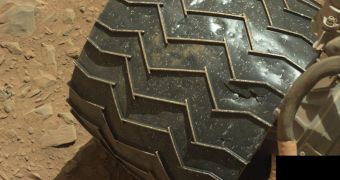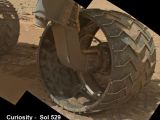Mission controllers at the NASA Jet Propulsion Laboratory (JPL) in Pasadena, California, may have to drive the Mars Science Laboratory (MSL) rover Curiosity over some fairly treacherous, dune-laden terrain soon, on account of the damage the rough surface of the Red Planet is causing to its wheels.
The robot is currently trekking through the massive Gale Crater, on its way to its primary science destination, the 5-kilometer (3-mile) tall Mount Sharp. Unfortunately, the road is filled with jagged rocks, which are causing heavy damage to the rover's aluminum wheels.
The damage is compounded by the fact that Curiosity weighs nearly 1 ton, and is the size of a Mini Cooper. After analyzing a series of new images the rover took of its wheels, mission specialists believe that a new navigation solution has to be developed in order to ensure that the mission is successfully completed, Universe Today reports.
The first holes in Curiosity's aluminum wheels were observed in the fall of 2013. Since then, JPL scientists have been monitoring any signs of change closely, and have determined that more and more holes and punctures are developing each passing month.
The exploration robot is currently heading for KMS-9, a highly desirable and nearby destination that promises excellent science opportunities. However, the path originally calculated for the rover is now being reassessed, with mission controllers reserving the option of diverting Curiosity through a more dangerous, but softer, terrain.
JPL investigators say that the spacecraft has advanced a total of 264.7 meters (865 feet) in January, for a total odometry of 4.89 kilometers (3.04 miles). As the frequency of drives increased, so too did the number of gashes and punctures in the wheels.
The left front wheel is especially worrying for scientists, since it has just developed a puncture some 5 to 8 centimeters (3 inches) in length and 3 centimeters (~1 inch) in width. However, the researchers have already thought of a solution to prevent further damage.
Before deciding on the path the rover should take, JPL scientists await a series of images from the High Resolution Imaging Science Experiment (HiRISE) instrument on the NASA Mars Reconnaissance Orbiter (MRO), which will reveal more about the particularities of the dune-laden stretch of sandy land ahead.
Curiosity took off from Space Launch Complex 41 (SLC-41) at the Cape Canaveral Air Force Station on November 26, 2011, aboard an Atlas V heavy-lift delivery system. The rover successfully landed on Mars on August 6, 2012, inside a Gale Crater structure called Aeolis Palus.

 14 DAY TRIAL //
14 DAY TRIAL // 
